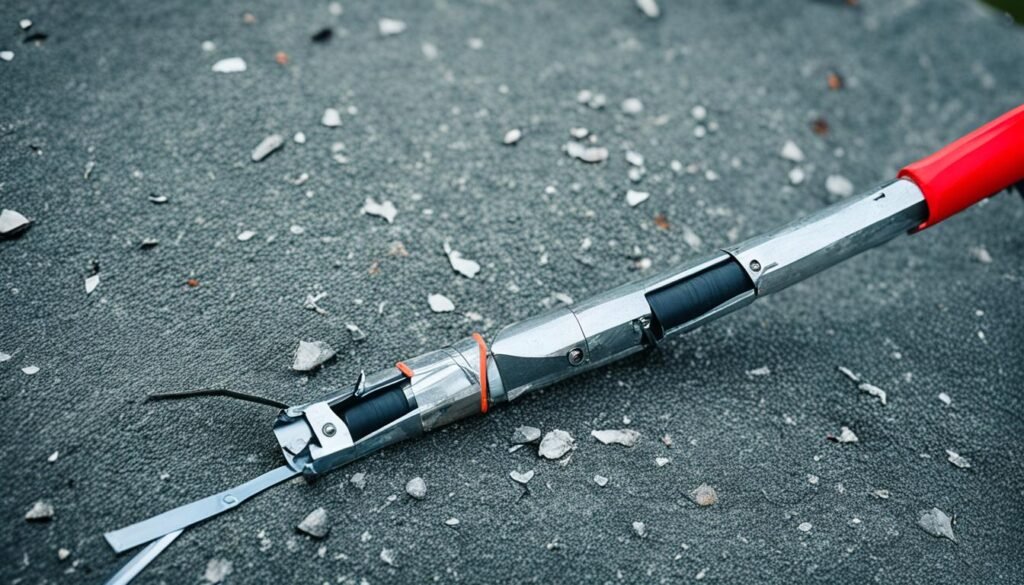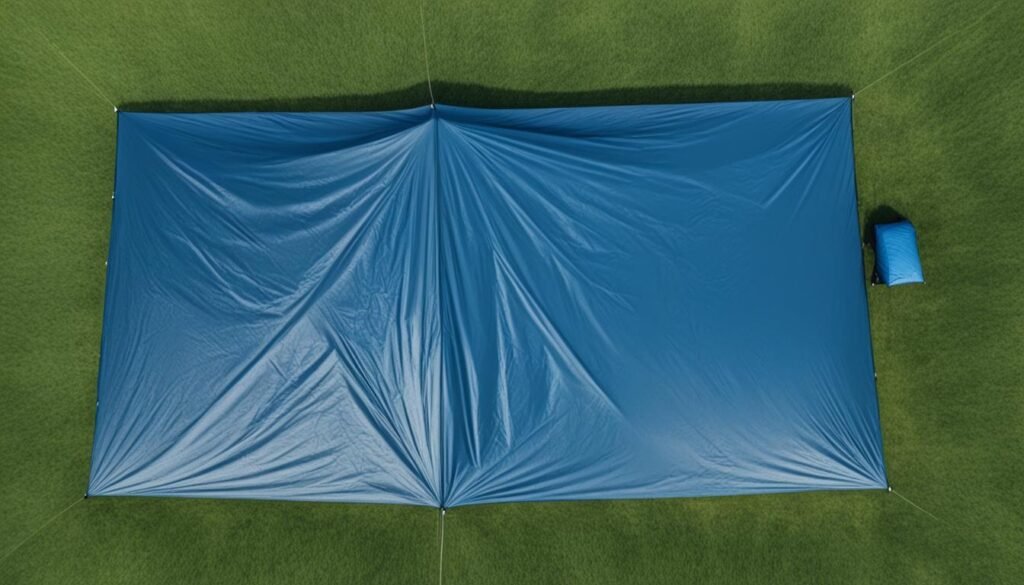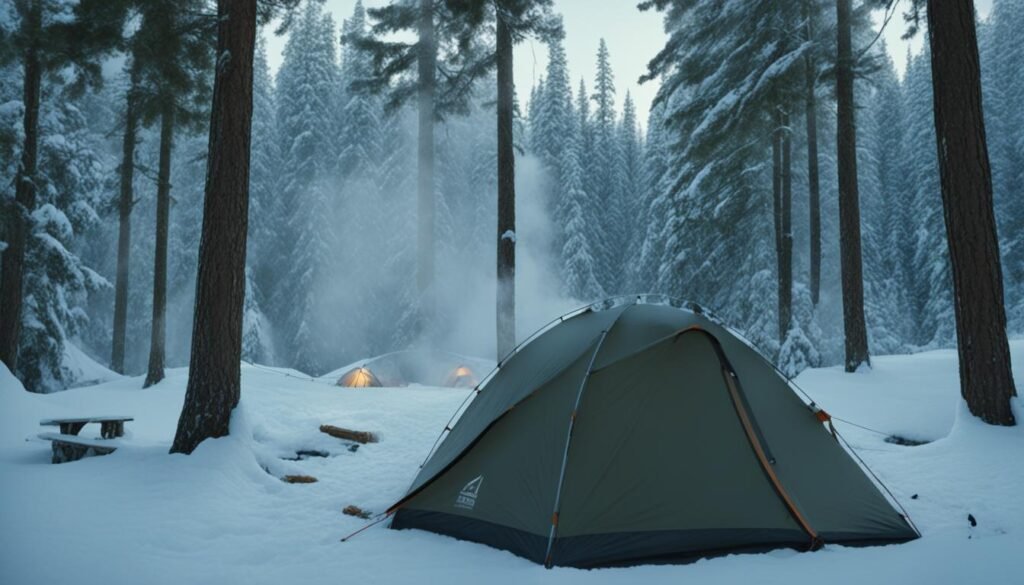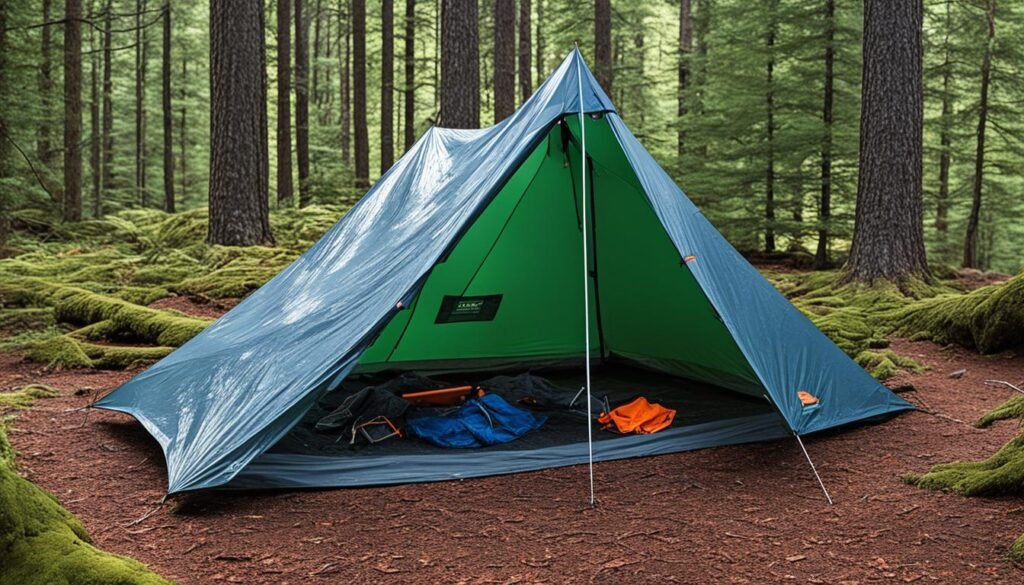If you’re an avid camper, you know that one of the most frustrating things that can happen is a broken tent pole. But don’t worry – fixing a broken tent pole is a relatively easy process that you can do yourself with just a few tools and some know-how. Understanding the anatomy of your tent pole is crucial in identifying and fixing the problem. Gathering the necessary materials for repair is an important step in the process. Basic repairs to a tent pole can be done with just a few tools and some know-how.
Key Takeaways:
- Fixing a broken tent pole is a relatively easy process that can be done DIY.
- Understanding the anatomy of your tent pole is important in identifying and fixing the problem.
- Gathering the necessary materials for repair is crucial.
- Basic repairs to a tent pole can be done with just a few tools and some know-how.
- A well-maintained tent pole is essential for ensuring the stability and longevity of your tent.
Understanding Tent Poles
Tent poles are an essential component of any camping trip, providing the necessary structure and stability to keep your tent standing strong. These poles are available in different types and materials, each offering unique characteristics that cater to specific camping needs.
There are three common types of tent poles:
- Aluminum poles: These poles are favored for their lightweight nature, making them ideal for backpackers and hikers who prioritize portability. Additionally, aluminum poles are rust-resistant, ensuring long-lasting durability even in damp or wet camping conditions.
- Fiberglass poles: Known for their flexibility, fiberglass tent poles are popular among campers who need to brace against strong winds or unpredictable weather conditions. These poles are also lightweight, making them easier to handle and transport.
- Steel poles: If stability and strength are your primary concerns, steel tent poles are the way to go. These poles offer unparalleled durability, making them suitable for larger tents or campers who don’t mind the extra weight. However, it’s important to note that steel poles are heavier compared to other options.
Understanding the various types of tent poles and their materials allows you to make an informed decision when selecting the most suitable pole for your camping adventures. Whether you prioritize lightweight portability, flexibility, or robust stability, there is a tent pole option that meets your specific needs.
Tent Pole Comparison
| Pole Material | Weight | Strength | Flexibility | Rust-Resistance |
|---|---|---|---|---|
| Aluminum | Lightweight | Moderate | Minimal | High |
| Fiberglass | Lightweight | Low | High | Low |
| Steel | Heavy | High | Low | Low |
Identifying the Problem
When it comes to tent pole issues, there are several common problems you may encounter that can compromise the stability and functionality of your tent. Identifying the specific problem with your tent pole is crucial in order to take the necessary steps to fix it and ensure your tent is secure and ready for your next outdoor adventure.
Common tent pole issues:
- Broken poles: A broken tent pole can render your entire tent useless. Whether it’s due to a heavy impact or wear and tear over time, identifying a broken pole is essential for repair.
- Bends: Bent tent poles can affect the overall structure and stability of your tent. These bends can be caused by strong winds, mishandling, or improper storage.
- Excess length: Sometimes, tent poles may be longer than necessary, causing difficulties in pitching the tent correctly. Identifying this issue is important to ensure a proper fit.
- Collapses: Tent pole collapses can occur when the tension or alignment is compromised. This can result in a sagging or collapsing tent, disrupting your camping experience.
By accurately identifying the problem, you can determine the appropriate course of action to resolve it. Whether it requires a quick fix or a more extensive repair, addressing these common tent pole issues will enhance the stability and longevity of your tent.
Remember, understanding the problem is the first step towards finding a solution. Take the time to carefully assess your tent pole and make note of any issues before proceeding with the repair process.
Gathering Materials for Repair
Before you can embark on repairing your tent pole, it’s crucial to gather all the necessary materials. Having these items on hand will make the repair process smoother and more efficient. Here are the essential tent pole repair materials you’ll need:
- Pole repair sleeve: A pole repair sleeve is a tube-like sleeve that reinforces a damaged section of your tent pole, providing extra support and stability.
- Duct tape or masking tape: These tapes are versatile and can be used to secure the repair sleeve or temporarily fix any other damaged areas.
- Pliers or a multi-tool: These tools come in handy for various repairs, such as positioning the repair sleeve or removing and replacing the shock cord.
- Tent pole repair kit (optional): A tent pole repair kit is a comprehensive set that includes various tools and materials specifically designed for tent pole repairs.
Now that you know what materials you’ll need, gather them before you start the repair process. Having everything readily available will save you time and ensure a successful repair.
| Materials | Description |
|---|---|
| Pole repair sleeve | A tube-like sleeve used to reinforce damaged tent pole sections, providing extra support and stability. |
| Duct tape or masking tape | Versatile tapes used to secure the repair sleeve or temporarily fix other damaged areas. |
| Pliers or a multi-tool | Tools used for positioning the repair sleeve, removing and replacing the shock cord, and other repairs. |
| Tent pole repair kit (optional) | A comprehensive set that includes various tools and materials specifically designed for tent pole repairs. |
Having these materials at your disposal will ensure that you can quickly and effectively repair your tent pole, allowing you to get back to your camping adventures without delay.
Note: The image below illustrates some of the materials required for tent pole repair.
Basic Repairs
When it comes to basic tent pole repairs, there are a few simple techniques you can use to fix common issues and get back to enjoying your camping trip. These methods may be temporary fixes, but they will provide the stability you need until a more permanent solution can be found.
Splinting a Broken Pole
If you have a broken pole, splinting is a quick and effective way to get it back in shape. Here’s how you can do it:
- Begin by aligning the broken sections of the pole, making sure they fit together snugly.
- Next, find a sturdy stick or branch that is slightly longer than the broken section.
- Position the splint alongside the break, providing support and stability.
- Secure the splint in place using strong duct tape, wrapping it tightly around the pole.
This makeshift splint will hold the broken pole together and allow you to continue using your tent until a proper repair or replacement can be made.
Using a Repair Sleeve
A repair sleeve is a handy tool that can reinforce a damaged section of your tent pole. Follow these steps to use a repair sleeve:
- Align the broken sections of the pole to ensure a proper fit.
- Slide the repair sleeve over the damaged area, covering the break completely.
- Secure the sleeve in place using duct tape, wrapping it tightly around the pole.
The repair sleeve provides additional support and stability, making it a reliable option for basic tent pole repairs.
Applying Duct Tape
In some cases, a simple application of duct tape can be enough to fix minor issues with your tent pole. Follow these steps:
- Identify the area of the pole that needs repair.
- Cut a piece of duct tape long enough to cover the damaged section.
- Wrap the duct tape tightly around the pole, covering the affected area.
Duct tape can provide temporary reinforcement and stability, allowing you to continue using your tent until a more permanent solution is available.
Advanced Repairs
When it comes to more complex tent pole repairs or severe damage, it may be necessary to consider advanced techniques or seek professional assistance. Two options for advanced repairs include replacing a shock cord and utilizing a professional tent pole repair service.
Replacing a Shock Cord
If your tent pole’s shock cord is damaged or worn out, you can replace it yourself with a few simple steps. Here’s how:
- Begin by removing the old shock cord from the pole sections.
- Cut a new shock cord to the appropriate length for your tent pole.
- Thread the new shock cord through the pole sections, ensuring it is secure.
- Tie knots at each end to prevent the shock cord from slipping out.
This process will restore the elasticity and functionality of the shock cord, contributing to the stability of your tent pole.
Professional Tent Pole Repair
If you’re not comfortable performing advanced repairs yourself or if your tent pole sustains significant damage, it’s recommended to rely on a professional tent pole repair service. These services have the experience and expertise to handle a wide range of repairs, including:
- Replacing broken sections of the tent pole.
- Repairing bent or misshapen poles.
By enlisting the help of a professional, you can ensure that your tent pole is repaired to the highest standard, restoring its structural integrity and extending its lifespan.
After considering these advanced repair options, you’ll be equipped with the knowledge to address more complex tent pole issues and maintain the stability of your camping shelter.
Temporary and Permanent Fixes
When your tent pole breaks, it can be a frustrating experience. However, there are temporary fixes and permanent solutions you can use to repair your tent pole. Creating a makeshift splint using duct tape and a tent stake can provide a temporary fix, while using a tent pole repair kit can offer a more permanent solution.
Temporary Fix: Creating a Makeshift Splint
If you find yourself in the middle of a camping trip with a broken tent pole, you’ll need a temporary fix to keep your tent standing. One option is to create a makeshift splint using duct tape and a sturdy stick or branch. This simple solution involves aligning the broken sections of the pole, positioning the splint alongside the break, and securing it with duct tape. While this is not a permanent solution, it can provide temporary stability until a more permanent repair can be made.
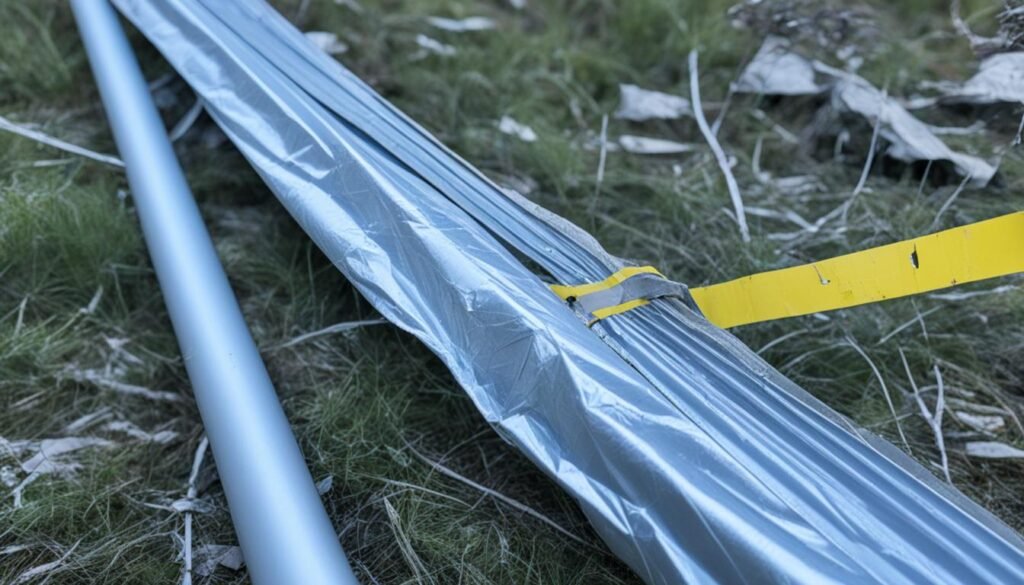
Permanent Solution: Tent Pole Repair Kit
If you want to ensure a long-lasting repair for your tent pole, using a tent pole repair kit is the way to go. These kits usually contain all the tools and materials you need to fix broken or damaged tent poles. They often include replacement shock cords, pole sleeves, and sections, as well as detailed instructions on how to make the repair. By following the provided instructions and using the components in the repair kit, you can restore your tent pole to its original strength and stability.
Using a tent pole repair kit offers several advantages. Firstly, it provides a permanent fix that will last throughout your camping trips and adventures. Secondly, it eliminates the need for improvised repairs that may not hold up well under different weather conditions. Lastly, it saves you the time and effort of searching for individual replacement parts, as everything you need is conveniently included in the kit.
Whether you choose a temporary fix or a permanent solution, it’s important to address the issue as soon as possible to prevent further damage to your tent. By having a plan in place for both temporary and permanent repairs, you can ensure that your camping trips go uninterrupted even in the face of a broken tent pole.
| Temporary Fixes | Permanent Repairs |
|---|---|
| Creates temporary stability | Offers a long-lasting repair |
| Relies on improvised materials | Utilizes specialized repair components |
| Requires periodic maintenance | Restores original strength and stability |
Maintaining Your Tent Poles
Regular maintenance of your tent poles is crucial to ensure their longevity and optimal performance. By following a few simple steps, you can keep your tent poles in great shape, preventing future damage and ensuring safe and enjoyable camping trips.
Proper Storage
To maintain your tent poles, start by storing them correctly. This means disassembling and cleaning the poles after each camping trip. Make sure they are completely dry before storing them in a cool, dry place away from direct sunlight and extreme temperatures. Avoid storing them in tight spaces that could cause unnecessary pressure.
Avoid Over-Bending or Over-Stressing
Tent poles can withstand a lot, but it’s important to avoid over-bending or over-stressing them. When setting up your tent, make sure to insert the poles gently and avoid putting excessive pressure on them. Be cautious when adjusting the tension of the tent fabric, as excessive force can strain the poles. Additionally, avoid leaning or hanging heavy objects on the poles, as this can cause damage.
Regular Inspections
It’s important to inspect your tent poles regularly for any signs of wear and tear. Check for cracks, dents, or bends that could compromise their structural integrity. Pay close attention to the connections between pole sections, as these areas can be prone to damage. If you notice any issues, address them promptly to prevent further damage.
By taking these maintenance steps, you can extend the lifespan of your tent poles and ensure they perform optimally for many camping adventures to come.
| Maintenance Tips | Benefits |
|---|---|
| Properly storing tent poles | Prevents bending and warping |
| Avoiding over-bending or over-stressing | Reduces risk of pole damage |
| Regular inspections | Identify and address issues early on |
Follow these maintenance tips to keep your tent poles in excellent condition, ensuring their reliability and your camping comfort.
Different Types of Tent Poles
When it comes to selecting tent poles, choosing the right type of pole is essential for ensuring the stability and durability of your tent. Tent poles are typically made from different materials, such as aluminum or fiberglass, each with its own unique characteristics and benefits.
Aluminum Tent Poles
Aluminum tent poles are a popular choice for campers due to their lightweight nature and excellent strength-to-weight ratio. They offer the advantage of being sturdy and durable while remaining relatively lightweight, making them ideal for backpacking and lightweight camping trips. Additionally, aluminum poles have the benefit of being rust-resistant, ensuring they withstand various weather conditions.
Fiberglass Tent Poles
Fiberglass tent poles are another common option known for their flexibility and affordability. These poles offer excellent shock absorption, making them particularly suitable for camping in windy conditions. While fiberglass poles may be slightly heavier compared to aluminum, they are still relatively lightweight and easy to carry. They are also more budget-friendly, making them a popular choice for casual campers.
Steel Tent Poles
Steel tent poles are the heaviest and most robust option among the different types of tent poles. They offer exceptional strength and durability, making them suitable for camping in rugged terrains or extreme weather conditions. However, due to their weight, steel poles are typically used for large and heavy-duty tents where stability is of utmost importance.
When selecting your tent poles, consider the type of camping you will be doing, the size and weight of your tent, and the weather conditions you are likely to encounter. An understanding of the different tent pole materials will help you make an informed decision and ensure that your tent is equipped with the right type of pole for your specific needs.
The Pros and Cons of Different Tent Pole Materials:
| Tent Pole Material | Pros | Cons |
|---|---|---|
| Aluminum | Lightweight, rust-resistant, high strength-to-weight ratio | Can be more expensive compared to fiberglass, may bend more easily than steel |
| Fiberglass | Flexible, affordable, excellent shock absorption | Can be heavier compared to aluminum, may break under extreme stress |
| Steel | Strong, durable, suitable for extreme conditions | Heavier compared to aluminum and fiberglass, prone to rust if not properly maintained |
Assessing the Damage
Before you start repairing your tent pole, I recommend assessing the extent of the damage. This step is crucial because it will help you determine the best course of action – whether a simple repair or a full replacement is necessary.
Small cracks or fractures may only require a temporary fix, while bends or full breaks may require more extensive repairs or replacements. By properly assessing the damage, you can make an informed decision and ensure that your tent pole is restored to its optimal condition.
In order to assess the tent pole damage accurately, follow these steps:
- Start by inspecting the entire length of the pole. Look for any visible signs of damage such as cracks, bends, or breaks.
- Pay close attention to areas where the pole connects to other components of the tent, as these junctions are more prone to stress and damage.
- If there are any cracks or fractures, gently run your fingers along the surface of the pole to feel for any irregularities or rough spots.
- Use a flashlight to examine the inside of the pole. Look for any splintering, delamination, or signs of corrosion.
- Take note of the severity and location of the damage.
By thoroughly assessing the tent pole damage, you’ll be better equipped to determine the most appropriate repair method or whether a replacement is necessary.

Common types of tent pole damage:
| Type of Damage | Description |
|---|---|
| Cracks or Fractures | Visible lines or openings in the pole material, compromising its structural integrity. |
| Bends | Unwanted curvature or misalignment along the length of the pole, making it difficult to properly set up the tent. |
| Breaks | Complete separation or detachment of the pole into two or more pieces, rendering it unusable. |
| Corrosion or Rust | Visible signs of oxidation and discoloration, typically caused by exposure to moisture or harsh environments. |
Remember, accurate assessment of tent pole damage is essential for effective repairs or replacements. It ensures the safety and stability of your tent, guaranteeing a successful camping experience.
Using a Pole Repair Sleeve
When it comes to repairing a damaged tent pole, a pole repair sleeve can be a valuable tool. This tube-like sleeve is designed to reinforce a broken or weakened section of the pole, providing additional support and stability.
The process of using a repair sleeve is relatively straightforward. First, you need to align the broken sections of the pole, making sure they fit together correctly. Once aligned, slide the repair sleeve over the damaged area, ensuring it covers the entire length of the break.
To secure the repair sleeve in place, use duct tape, wrapping it tightly around the sleeve and the adjacent sections of the pole. This will create a strong bond, effectively holding the repair sleeve in place and preventing any further movement or damage.
Advantages of Using a Pole Repair Sleeve
Using a pole repair sleeve offers several advantages:
- Cost-effective: Repair sleeves are relatively inexpensive compared to replacing an entire tent pole.
- Convenience: Repair sleeves are lightweight and easy to carry, making them a convenient solution for on-the-go repairs during camping trips.
- Temporary fix: While a repair sleeve may not be a permanent solution, it can extend the lifespan of a damaged pole and provide stability until a full repair or replacement can be made.
However, it’s important to note that a pole repair sleeve is not a foolproof solution for every type of tent pole damage. In some cases, more extensive repairs or replacements may be necessary to ensure the structural integrity of the pole.
An Example of a Pole Repair Sleeve Application
Table: Step-by-step Guide to Using a Pole Repair Sleeve
| Steps | Description |
|---|---|
| 1 | Align the broken sections of the tent pole to ensure a proper fit. |
| 2 | Slide the repair sleeve over the damaged area, ensuring it covers the entire length of the break. |
| 3 | Secure the repair sleeve in place by tightly wrapping duct tape around the sleeve and adjacent sections of the pole. |
Remember, using a pole repair sleeve is just one method for repairing a damaged tent pole. Depending on the extent of the damage and your level of expertise, you may need to explore other repair techniques or seek professional assistance.
Creating a Makeshift Splint
When faced with a broken tent pole and lacking a repair sleeve, you can resort to creating a makeshift splint using a few simple materials. This temporary solution allows you to restore stability to your tent pole until a more permanent fix can be implemented.
- Step 1: Start by aligning the broken sections of the pole, ensuring they are in their proper position.
- Step 2: Find a sturdy stick or branch that is long enough to cover the broken area of the pole.
- Step 3: Position the splint alongside the break, ensuring it provides support and stability.
- Step 4: Secure the splint in place using duct tape, wrapping it tightly around the pole and the splint.
This makeshift splint helps hold the broken sections together, preventing further damage and allowing you to continue using your tent. However, it is important to note that this solution is temporary and should be replaced with a proper repair or replacement as soon as possible.
| Materials | Instructions |
|---|---|
| Sturdy stick or branch | Locate a stick or branch that is long enough to cover the broken area of the pole. |
| Duct tape | Use duct tape to secure the splint in place, wrapping it tightly around the pole and the splint. |
Replacing a Shock Cord
If you’ve discovered that the shock cord in your tent pole is broken, there’s no need to panic. With a few simple steps, you can easily replace the shock cord yourself, restoring the elasticity and functionality of your tent pole. Here’s a step-by-step guide on how to replace a shock cord:
- Start by removing the old, damaged shock cord from your tent pole. Carefully untie any knots or remove any clips keeping the cord in place.
- Measure and cut a new shock cord to the appropriate length. It’s crucial to ensure that the replacement cord is of the correct length to maintain the tension in your tent pole.
- Take one end of the shock cord and tie a secure knot or attach a small clip to prevent it from slipping through the pole sections.
- Gently thread the other end of the shock cord through the pole sections, carefully pulling it through until it reaches the other end. Be cautious not to damage or snag the cord during this process.
- Once the shock cord is threaded through all the pole sections, tie a knot or attach a clip to secure it in place.
By following these steps, you can successfully replace the shock cord in your tent pole. This DIY repair will ensure that your tent remains stable and secure during your camping adventures.
Remember, it’s always a good idea to inspect your shock cord regularly and replace it as soon as you notice any signs of wear or damage. Taking proactive steps to maintain your tent poles will help prolong their lifespan and ensure a safe camping experience.
For visual reference, below is an illustration demonstrating the process of replacing a shock cord in a tent pole:
| Illustration: Replacing a shock cord in a tent pole |
Professional Tent Pole Repair
If you’re not confident in your DIY repair skills or if the damage to your tent pole is significant, it’s best to enlist the help of a professional repair service. Companies like Tentpole Technologies specialize in tent pole repairs and offer a range of services, including replacing broken sections and repairing bent poles. Using a professional service ensures that your tent pole is repaired to the highest standard, ensuring its structural integrity.
If you’re not confident in your DIY repair skills or if the damage to your tent pole is significant, it’s best to enlist the help of a professional tent pole repair service. Companies like Tentpole Technologies specialize in tent pole repairs and offer a range of services, including replacing broken sections and repairing bent poles. Using a professional service ensures that your tent pole is repaired to the highest standard, ensuring its structural integrity.
“Companies like Tentpole Technologies specialize in tent pole repairs and offer a range of services, including replacing broken sections and repairing bent poles.”
If you’re faced with a complex tent pole issue or simply don’t have the time or expertise to handle the repair yourself, a professional tent pole repair service can provide the expertise and experience needed to get your pole back in top shape. Whether you’re dealing with a severely bent pole or a complete break, these professionals have the knowledge and tools to effectively assess and address the problem.
Professional tent pole repair services have access to specialized equipment and materials that may not be readily available to consumers. This allows them to perform more intricate repairs, such as replacing broken sections or repairing bent poles, with precision and expertise. By entrusting your tent pole repair to the professionals, you can have peace of mind knowing that your tent will be safe and secure on your next camping adventure.
Additionally, professional repair services often offer warranties or guarantees on their work. This means that if any issues arise with the repaired pole in the future, you can rely on the service provider to rectify the problem. This level of assurance and quality control is invaluable when it comes to preserving the longevity and functionality of your tent pole.
The Benefits of Professional Tent Pole Repair
There are several key benefits to opting for a professional tent pole repair service:
- Expertise: Professional repair technicians have extensive knowledge and experience in dealing with a wide range of tent pole issues. They can quickly identify the problem and determine the most effective solution.
- Efficiency: By relying on professionals, you can save time and effort since they will efficiently repair your tent pole, allowing you to focus on other important aspects of your camping trip.
- Quality: Professional repair services have access to high-quality materials and tools, ensuring that your tent pole is repaired to the highest standard. This guarantees its structural integrity and longevity.
- Peace of Mind: Knowing that your tent pole has been professionally repaired gives you confidence in its stability and reliability. You can rest easy during your camping trips, knowing that your tent is secure and safe.
For those seeking convenience, quality, and peace of mind, professional tent pole repair services are an excellent option. By entrusting the repair to experienced professionals, you can rest assured that your tent pole will be in good hands and ready for your next outdoor adventure.
Conclusion
Taking the time to learn how to repair your tent pole is essential for any camping enthusiast. With the right knowledge and tools, you can confidently fix common tent pole issues and ensure the stability and longevity of your tent. Whether it’s splinting a broken pole, using a repair sleeve, or replacing a shock cord, basic repairs can be easily done on your own.
However, it’s important to prioritize safety and consult professional help if the damage is severe or if you’re not confident in your DIY skills. Companies like Tentpole Technologies offer professional tent pole repair services, specializing in more complex repairs and providing solutions for bent poles or broken sections.
Remember that maintaining your tent poles is equally important. Regular inspections, proper storage, and avoiding over-stressing the poles will prevent future damage and ensure your camping trips are safe and enjoyable. By taking care of your tent poles, you’re investing in the overall stability and success of your camping experience.
FAQ
What materials are tent poles made of?
Tent poles can be made from various materials, including aluminum, fiberglass, and steel. Each material has its own advantages and disadvantages, so it’s important to choose the right type of pole for your needs.
What are some common tent pole issues?
Common tent pole issues include broken poles, bends, excess length, and collapses. Identifying the specific problem with your tent pole is important so that you can take the necessary steps to fix it.
What materials do I need to repair a tent pole?
To repair a tent pole, you may need a pole repair sleeve, duct tape or masking tape, pliers or a multi-tool, and potentially a tent pole repair kit. Having these materials on hand will make the repair process much smoother.
What are some basic repairs I can do for my tent pole?
Basic repairs for tent poles can include splinting a broken pole, using a repair sleeve, and applying duct tape. These methods are temporary fixes but will help you get back to enjoying your camping trip until a more permanent solution can be found.
Should I attempt advanced repairs on my tent pole?
If you’re comfortable with more advanced repairs or if your tent pole is severely damaged, you may consider replacing a shock cord or using a professional tent pole repair service. Replacing a shock cord can be done with a few simple steps, while professional repair services can handle more complex repairs.
Are there temporary fixes for a broken tent pole?
Yes, if your tent pole breaks, you can create a makeshift splint using duct tape and a tent stake. While this is not a permanent solution, it can provide temporary stability until you can find a more permanent fix.
How do I maintain my tent poles?
Regular maintenance of your tent poles is important to ensure their longevity and performance. This may include proper storage, avoiding over-bending or over-stressing the poles, and regular inspections for any signs of wear and tear.
What are the different types of tent poles?
Tent poles can be made from different materials, such as aluminum or fiberglass. Aluminum poles are lightweight and rust-resistant, fiberglass poles are lightweight and flexible, and steel poles are strong but heavy. Understanding the differences between these materials can help you make an informed decision when selecting a tent pole.
How do I assess the damage to my tent pole?
Before repairing your tent pole, it’s crucial to assess the extent of the damage. Small cracks or fractures may only require a temporary fix, while bends or full breaks may require more extensive repairs or replacements.
How do I use a pole repair sleeve?
A pole repair sleeve is a tube-like sleeve that can be used to reinforce a damaged section of your tent pole. To use a repair sleeve, you need to align the broken sections, slide the sleeve over the damaged area, and secure it in place with duct tape.
Is there a temporary fix for a broken shock cord?
If your tent pole has a broken shock cord, you can replace it yourself by removing the old cord, cutting a new shock cord to length, and threading it through the pole sections. By tying knots at each end, you can ensure the cord stays in place.
Should I use a professional tent pole repair service?
If you’re not confident in your DIY repair skills or if the damage to your tent pole is significant, it’s best to enlist the help of a professional repair service. Companies like Tentpole Technologies specialize in tent pole repairs and offer a range of services, including replacing broken sections and repairing bent poles.
What are the benefits of learning how to repair my tent pole?
Taking the time to learn how to repair your tent pole is essential for any camping enthusiast. With the right knowledge and tools, you can confidently fix common tent pole issues and ensure the stability and longevity of your tent.

